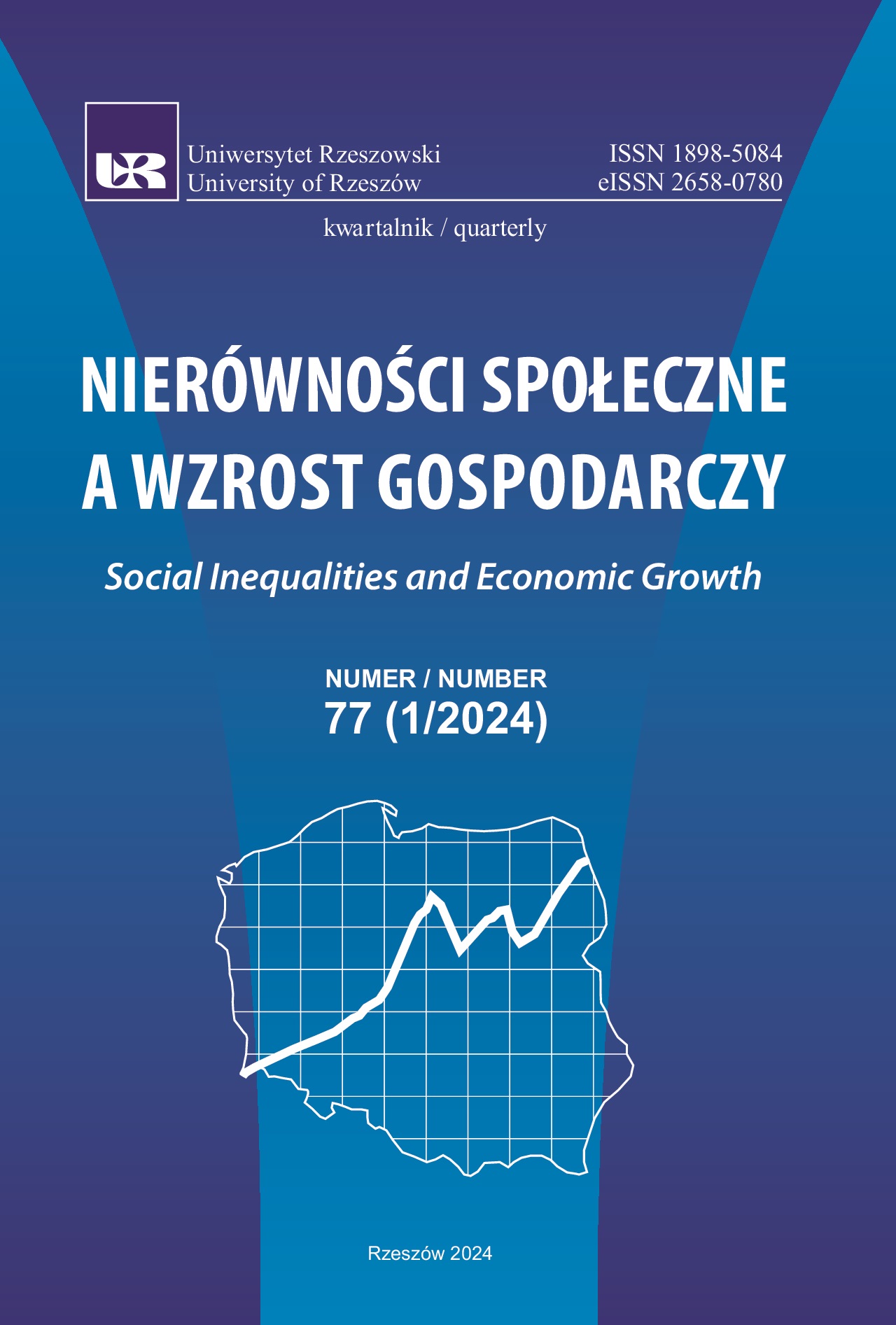The phenomenon of inflation and monetary policy in Poland in recent years
DOI:
https://doi.org/10.15584/nsawg.2024.1.5Keywords:
inflation, monetary policy, central bank, money supplyAbstract
The aim of the article is to analyse the problem of inflation and the reaction to it in the economic situation in which Poland has found itself in recent years. The author first addresses the fundamental issue of defining inflation. He indicates that inflation is a process of price changes. However, inflation is commonly misidentified as a measure of its annual effects. As a result, in a situation where prices have not changed for several months – according to this definition, there is no inflation – yet prices are higher than 12 months earlier, resulting in an annual rate of several percent, it is said that inflation is still high. The author emphasizes that a common methodological error consists in confusing a phenomenon with its measure, or more precisely, with the measure of its annual effects. This not only fuels inflation expectations, but may lead to excessively restrictive monetary policy. Using a simple example, the author shows that monetary policy cannot be guided by the indications of the inflation measure, the value of which depends on what happened to prices a year earlier, but should be guided by the observation of changes in the monthly measure and assessments of its future developments. The author indicates that the causes of inflation are both supply and demand, external and internal. He emphasises that the central bank has no influence on inflation when the causes are external and supply-related, resulting from an increase in external costs. He also highlights that the central bank has no influence when external demand causes inflation. He draws attention to the fact that in Poland, what was important, was the increase in demand resulting from the inflow of people from Ukraine and, as a result, demand. The author reminds that the central bank has a direct impact on the money market with its monetary policy and can effectively reduce inflation when it is caused by credit expansion and, as a result, an excessive increase in demand in which case the tightening of monetary policy is aimed at reducing this credit expansion. Using statistical data, it shows that there was no excessive expansion of credit, the money stock, after a short-term increase at the beginning of the pandemic, returned to the value before the pandemic crisis, and loans and receivables in relation to GDP decreased, as a result of which the scope of influence of monetary policy narrowed. This did not provide grounds for tightening it, which was suggested in economic journalism – especially with the persisting high excess liquidity of the banking sector. The author emphasised that, in monetary policy, it is necessary to bear in mind that the strength and stability of money cannot be built by weakening and destabilising the economy.
Downloads
References
Assay index 2022 (2022). Wskaźnik gotowości inwestycyjnej Polaków. Warszawa: Assaygroup. Pobrane z: https://assay.pl/strefa-inwestora/raporty-assay/assay-index-2022/ (2023.11.13).
Balestra, C., Tonkin, R. (2018). Inequalities in household wealth across OED countries: Evidence from the OECD Wealth Distribution Database. OECD Statistics Working Papers, 01, 1–69. DOI: 10.1787/7elbf673-en.
Białek, J. (2019). Metodologia pomiaru inflacji: stan obecny i wyzwania. Warszawa: Uniwersytet Łódzki, Główny Urząd Statystyczny.
Galbraith, J.K. (2005). Gospodarka niewinnego oszustwa, Prawda naszych czasów. Warszawa: Wydawnictwo MT Biznes.
Ilu uchodźców z Ukrainy jest w Polsce. Pobrane z: https://300gospodarka.pl/news/uchodz¬cy-z-ukrainy-w-polsce-liczba (2023.11.13).
Miesięczne wskaźniki cen towarów i usług konsumpcyjnych od 1982 roku. Pobrane z: https://stat.gov.pl/obszary-tematyczne/ceny-handel/wskazniki-cen/wskazniki-cen-towarow-i-uslug-konsumpcyjnych-pot-inflacja-/miesieczne-wskazniki-cen-towarow-i-uslug-konsumpcyjnych-od-1982-roku/ (2023.11.13).
James, H. (2021). Historia Banku Anglii, Jak powstawał nowoczesny bank centralny. Warszawa: PWN.
PFR podsumował program Tarcz Finansowych PFR. Pobrano z: pfrsa.pl (2023.11.13).
Problemy turystów w Chorwacji. Wprowadzenie euro spowodowało skok cen nawet o 100 proc. Pobrano z: https://forsal.pl/lifestyle/turystyka/artykuly/8743725,problemy-turystow-w-chorwacji-wprowadzenie-euro-spowodowalo-skok-cen.html) (2023.11.13).
Spencer, M.H. (1977). Contemporary Macroeconomics. Hampshire: Worth Publishers.
Stiglitz, J.E., Fitoussi, J-P., Durand, M. (2019). Poza PKB mierzmy to, co ma znaczenie dla rozwoju społeczno-gospodarczego. Warszawa: Polskie Towarzystwo Ekonomiczne. DOI: https://doi.org/10.1787/e2b4d21b-pl
Tarullo, D.K. (2017). Monetary Policy Without a Working Theory of Inflation. Hutchins Center Working Paper, 33, 1–18.
Żyżyński, J. (1997). Pieniądz a transformacja gospodarki. Warszawa: Wydawnictwo Uniwersytetu Warszawskiego.
Żyżyński, J. (2017). Statystyka opisowa i matematyczna dla zarządzania. Warszawa: Wydawnictwa Naukowe Wydziału Zarządzania Uniwersytetu Warszawskiego.
Downloads
Published
How to Cite
Issue
Section
License
Copyright (c) 2024 University of Rzeszow

This work is licensed under a Creative Commons Attribution-NonCommercial-NoDerivatives 4.0 International License.


